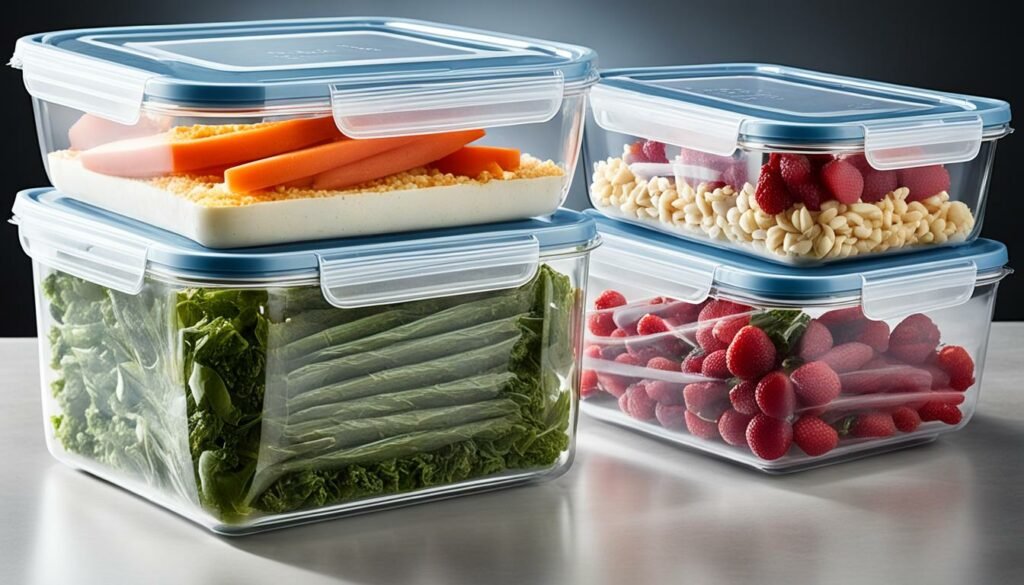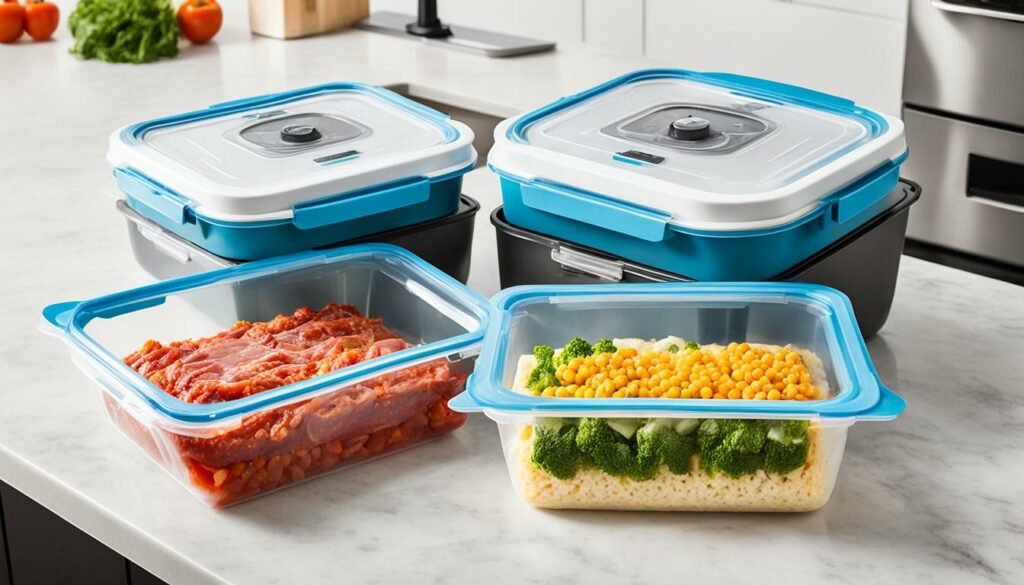Is vacuum sealing truly the best food storage method? When I started looking into food preservation, I found a new option: airtight containers. These simple containers might change the way we keep our food fresh.

In my search for better food saving choices, I found ANKOMN’s “TRUE” airtight canisters. They use a special “air-block” feature to block air by turning just 45 degrees. This is much easier than using a vacuum sealer.
The debate between airtight containers and vacuum sealing is getting interesting. While people usually rely on vacuum sealing, new research shows airtight containers can work just as well. This idea has made me rethink the best way to store food.
Every year, Americans throw away an astonishing 27 million tons of food, costing $144 billion. Clearly, we need a better way to store food. Could airtight containers offer a solution? Let’s dive into this option and find the best food storage method for every kitchen.
Understanding Food Preservation Methods
Preserving food is crucial for making it last longer and keep its quality. We’ll look into why food goes bad and the tools we use to store it, like airtight containers and vacuum sealing machines.
The Science Behind Food Spoilage
Food spoils mainly from sunlight, mold, and when it gets exposed to air. Bacteria love food that’s moist and rich, especially with oxygen. Ways to keep food fresh often cut off these necessities for bacteria. Vacuum sealing and airtight containers are good at this by taking air away.
Traditional Preservation Techniques
Throughout history, people have used canning and drying to store food for longer. These methods either dry the food out or make it a bad place for germs to live. But, they can change how the food looks and tastes.
Modern Storage Solutions
Now, we have new ways to store food like vacuum sealing and special airtight containers. Let’s see how they compare:
| Feature | Vacuum Sealing | Airtight Containers |
|---|---|---|
| Air Removal | Complete | Partial |
| Shelf Life Extension | 3-5 times longer | 1-2 times longer |
| Versatility | Suitable for most foods | Limited by container size |
| Cost | Higher initial investment | More affordable |
When we look at airtight containers versus vacuum sealing, the latter is a winner. It can make food last up to 5 times longer than older methods. Some containers, such as the ANKOMN EVERLOCK series, work extra well by just turning them 45 degrees.
Knowing these methods helps select the right one for keeping your food fresh longer.
Airtight Containers vs Vacuum Sealing: A Comprehensive Comparison
I’ve checked out airtight containers and vacuum sealing to help you pick one for your food storage. We’ll look at how they each work and what their good and bad points are.
How Airtight Containers Work
Airtight containers stop air from getting in or out. Real airtight containers block all air. An airtight container called Ankomn kept its weight in an alcohol test compared to one that lost 8%.
The Vacuum Sealing Process
Vacuum sealing sucks the air out before sealing. The Zwilling Fresh & Save system makes food last five times longer than usual. It seals containers in just 30 seconds, which is fast.
Pros and Cons of Each Method
Let’s look at the good and bad of airtight containers and vacuum sealing:
| Aspect | Airtight Containers | Vacuum Sealing |
|---|---|---|
| Food Preservation | Minimal long-term preservation | Extends shelf life up to 5x longer |
| Ease of Use | Simple to use | Requires special equipment |
| Versatility | Suitable for various foods | Limited by container/bag size |
| Cost | Generally more affordable | Higher initial investment |
| Effectiveness for Coffee | Less effective | Preferred by coffee experts |
Airtight containers are easy to use and cheaper, but vacuum sealing keeps food better. For coffee, vacuum canisters like Atmos make coffee last longer. They’re the favorite for keeping coffee fresh.
Benefits of Using Airtight Containers for Food Storage
Airtight containers are a smart choice for keeping your food fresh. They offer many benefits that other methods, like vacuum sealers, don’t. Exploring these benefits will show you why many people choose them for their kitchen.
Cost-Effectiveness and Accessibility
Buying airtight containers won’t put a dent in your wallet. They’re widely available at local stores and online. You don’t need to buy special bags or equipment like you do with vacuum sealers. Airtight containers are a simple, long-lasting investment.

Versatility in Storage Options
Airtight containers come in many shapes and sizes. This makes them perfect for keeping various foods fresh. Whether you’re saving leftovers or fresh fruit, there’s a container that fits. Their flexibility outshines vacuum sealers significantly.
Ease of Use and Convenience
Using airtight containers is a piece of cake. You can easily fill, seal, and open them without hassle. Plus, they’re dishwasher, microwave, and freezer safe. This makes them perfect for everyday food storage needs.
| Feature | Airtight Containers | Vacuum Sealers |
|---|---|---|
| Initial Cost | Low | High |
| Ongoing Expenses | None | Replacement bags |
| Versatility | High | Limited |
| Ease of Use | Very Easy | Requires practice |
Maximizing Food Freshness with Airtight Containers
Using airtight containers is top-notch for storing food. With some easy steps, you can keep your food fresh for longer and cut waste.
Start by picking the right-sized container for your food. This stops air from getting in and preserves freshness. For dried and dehydrated foods, add oxygen absorbers. They help keep things fresh longer.
Keeping your containers clean is key. I always thoroughly wash them before using to keep food safe and fresh.
If your food gets moist easily, use moisture absorbers along with airtight containers. This little extra can really keep your food quality up.
| Food Type | Airtight Container | Additional Storage Tip | Expected Shelf Life |
|---|---|---|---|
| Dry Pasta | Glass or BPA-free plastic | Add oxygen absorber | 1-2 years |
| Coffee Beans | Opaque, airtight canister | Store in cool, dark place | 2-4 weeks |
| Dried Fruits | Glass jar with tight seal | Include moisture absorber | 6-12 months |
| Nuts | Vacuum-sealed container | Refrigerate after opening | 3-6 months |
Follow these tips to set up the best food storage in your home. Airtight containers do more than just keep food fresh. They also tidy up your pantry and save you money by reducing waste.
Conclusion
I’ve looked into airtight containers vs vacuum sealing for food storage. Airtight containers are better for daily use. They’re cheap, simple, and fit many kitchen needs well.
Choose based on what you need. Airtight containers are easy to use and keep food fresh. Some like ANKOMN EVERLOCK and Turn-N-Seal offer more protection.
The best choice depends on what you’re storing and for how long. For most cooks, airtight containers are a great choice. They’re easy and effective. This makes them perfect for keeping food fresh and good to eat.
FAQ
What are the main advantages of using airtight containers for food storage?
Airtight containers have many perks. They save money, adapt to different foods, and are easy to use. They clean easily and can be used again. The ANKOMN EVERLOCK is a prime example of a container that seals well.
How do airtight containers prevent food spoilage?
Airtight containers stop food from getting too much air. This keeps bacteria and mold away. While they don’t remove all air, they cut down on it enough to lower spoilage risks.
Can airtight containers replace vacuum sealing for long-term food storage?
Airtight containers are good for dehydrated and dry foods over a long time. For the best results, add oxygen absorbers to the container. Pick the right container size to stop too much air from getting in.
What are the key differences between airtight containers and vacuum sealing?
Airtight containers keep air at bay, but vacuum sealing takes the air out completely. Vacuum sealing works better for no freezer burn, but you need special gear. Airtight containers are simpler and work for many foods, yet they can’t completely stop air.
How can I maximize food freshness when using airtight containers?
Maximizing food freshness means keeping the air out. Use the right-sized container to store food. For dry and dehydrated foods, airtight containers with oxygen absorbers work well. Clean and keep containers in good shape. The ANKOMN EVERLOCK has an excellent seal for this.
